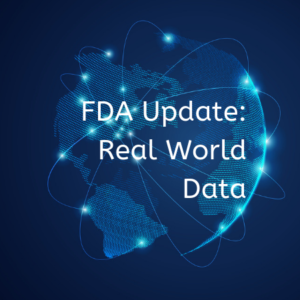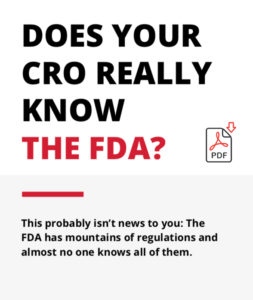FDA Publishes Framework for Real-World Evidence Program
In December of 2018, the FDA published their Framework for FDA’s Real-World Evidence Program, which outlines the allowed usage of Real World Data (RWD) and Real World Evidence (RWE) in FDA submissions.
The sources of RWD and the application of RWE
The rationale for using Real-World Data (RWD) is to help support the approval of a new indication for a drug approved under the Federal Food, Drug, and Cosmetic Act (FD&C Act) and to help support or satisfy post-approval study requirements.
RWD can come from a number of sources, for example:
- Electronic health records (EHRs)
- Claims and billing activities
- Product and disease registries
- Patient-generated data including in home-use settings
- Data gathered from other sources that can inform on health status, such as mobile devices;
The FDA uses RWD to monitor post-market safety and adverse events and to make regulatory decisions. At the same time, medical product developers use RWD and Real-World Evidence (RWE) to support clinical trial designs and observational studies to generate innovative, new treatment approaches.
In the “Guidance for Industry and Food and Drug Administration Staff : Use of Real World Evidence to Support Regulatory Decision –Making for Medical Device,” launched in 2017, the FDA stated that the above mentioned RWD sources can be used as data collection and analysis infrastructure to support many types of trial designs, including, but not limited to, randomized trials, such as large simple trials, pragmatic clinical trials, and observational studies (prospective and/or retrospective). Furthermore, the FDA has been implementing the National Evaluation System for health Technology (NEST) to leverage RWD in order to more quickly identify safety problems and to better understand the benefit-risk profile of devices used in clinical care. Whether RWE provides an acceptable level of valid scientific evidence or not depends on whether the RWD are of sufficient quality, that is, whether RWD were accurately and reliably captured at clinically relevant time intervals throughout the device lifecycle. Under the right conditions, RWE may be suitable to support the clearance or approval of a new device, or the expansion of the indications for use of devices that are already on the market.
RWE may also be used to supplement the total evidence required for such clearances or approvals. Other applications of RWE in premarket decision-making may also be possible, particularly as RWD systems and analysis methodology advance.
Case study for using RWD and RWE in FDA New drug/device application
Though the program for using RWD and RWE is in process of awaiting public comments, the FDA has practiced RWD and RWE in previous approvals of drug applications. For example, in the October 18, 2018 meeting for Prucalopride (Motegrity), the FDA agreed to use the data from two non-interventional studies for a long-term safety submission. One of the studies is a non-interventional pharmacoepidemiology study that used national claims data from four European countries, and another one is a non-interventional epidemiologic study conducted to estimate the adjusted incidence ratio for MACE. In the same application, the FDA agreed to use the data from a phase 3 trial conducted in 1999 to support the generalizability of results from non-US pivotal studies to the US patients’ population.
With this successful case, we expect more and more new applications for drugs and medical devices using RWD and RWE. This will reduce the cost of drug development and shorten the time of new drug/device approval, especially in the data related to safety and benefit-risk assessment.
RWD and RWE: FDA’s focus
At the end of 2018, the FDA published two documents regarding Real-World Data (RWD) and Real-World Evidence (RWE). The Statement on FDA’s new strategic framework to advance use of RWD and RWE support development of drugs and biologics was released on December 6, 2018. The framework for FDA’s Real-World Evidence Program was launched in FDA web site on December 19, 2018. The purposes of RWD and RWE are to help inform regulatory decisions around medical products as the collection of this data gets more widespread and reliable.
In terms of definition from the FDA, RWD are data relating to patient health status and/or the delivery of health care routinely collected from a variety of sources. RWD offer new opportunities to generate evidence and better understand clinical outcomes. These data may be derived from a diverse array of sources, such as electronic health records (EHR), medical claims, product and disease registries, laboratory test results and even cutting-edge technology paired with consumer mobile devices.
RWE is the clinical evidence about the usage and potential benefits or risks of a medical product derived from analysis of RWD. Under the FDA’s RWE Program, evidence from traditional clinical trials will not be considered RWE. However, various hybrid or pragmatic trial designs and observational studies could generate RWE. The FDA’s RWE Program will cover clinical trials that generate RWE in some capacity (i.e., sources other than traditional clinical trials) and observational studies.
Next Steps:
- Read more about Real World Data
- See how Princeton’s services can help you.
- Subscribe to our blog to stay on top of FDA News